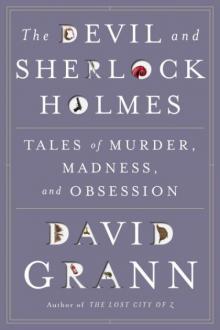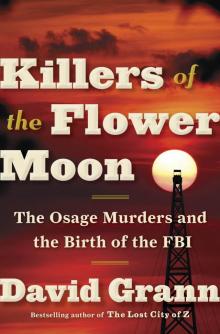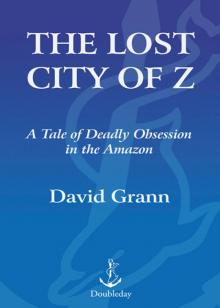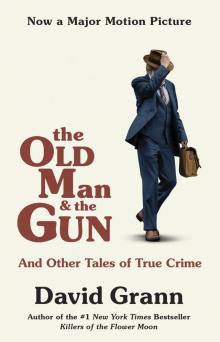- Home
- David Grann
The Devil & Sherlock Holmes: Tales of Murder, Madness & Obsession Page 7
The Devil & Sherlock Holmes: Tales of Murder, Madness & Obsession Read online
Page 7
Willingham had often not treated her well, she recalled, and after his incarceration she had left him for a man who did. But she didn’t think that her former husband should be on death row. “I don’t think he did it,” she said, crying.
Though only the babysitter had appeared as a witness for the defense during the main trial, several family members, including Stacy, testified during the penalty phase, asking the jury to spare Willingham’s life. When Stacy was on the stand, Jackson grilled her about the “significance” of Willingham’s “very large tattoo of a skull, encircled by some kind of a serpent.”
“It’s just a tattoo,” Stacy responded.
“He just likes skulls and snakes. Is that what you’re saying?”
“No. He just had—he got a tattoo on him.”
The prosecution cited such evidence in asserting that Willingham fit the profile of a sociopath, and brought forth two medical experts to confirm the theory. Neither had met Willingham. One of them was Tim Gregory, a psychologist with a master’s degree in marriage and family issues, who had previously gone goose hunting with Jackson, and had not published any research in the field of sociopathic behavior. His practice was devoted to family counselling.
At one point, Jackson showed Gregory Exhibit No. 60—a photograph of an Iron Maiden poster that had hung in Willingham’s house—and asked the psychologist to interpret it. “This one is a picture of a skull, with a fist being punched through the skull,” Gregory said; the image displayed “violence” and “death.” Gregory looked at photographs of other music posters owned by Willingham. “There’s a hooded skull, with wings and a hatchet,” Gregory continued. “And all of these are in fire, depicting—it reminds me of something like Hell. And there’s a picture—a Led Zeppelin picture of a falling angel. . . . I see there’s an association many times with cultive-type of activities. A focus on death, dying. Many times individuals that have a lot of this type of art have interest in satanic-type activities.”
The other medical expert was James P. Grigson, a forensic psychiatrist. He testified so often for the prosecution in capital-punishment cases that he had become known as Dr. Death. (A Texas appellate judge once wrote that when Grigson appeared on the stand the defendant might as well “commence writing out his last will and testament.”) Grigson suggested that Willingham was an “extremely severe sociopath,” and that “no pill” or treatment could help him. Grigson had previously used nearly the same words in helping to secure a death sentence against Randall Dale Adams, who had been convicted of murdering a police officer, in 1977. After Adams, who had no prior criminal record, spent a dozen years in prison—and once came within seventy-two hours of being executed—new evidence emerged that absolved him, and he was released. In 1995, three years after Willingham’s trial, Grigson was expelled from the American Psychiatric Association for violating ethics. The association stated that Grigson had repeatedly arrived at a “psychiatric diagnosis without first having examined the individuals in question, and for indicating, while testifying in court as an expert witness, that he could predict with 100-per-cent certainty that the individuals would engage in future violent acts.”
After speaking to Stacy, Gilbert had one more person she wanted to interview: the jailhouse informant Johnny Webb, who was incarcerated in Iowa Park, Texas. She wrote to Webb, who said that she could see him, and they met in the prison visiting room. A man in his late twenties, he had pallid skin and a closely shaved head; his eyes were jumpy, and his entire body seemed to tremble. A reporter who once met him described him to me as “nervous as a cat around rocking chairs.” Webb had begun taking drugs when he was nine years old, and had been convicted of, among other things, car theft, selling marijuana, forgery, and robbery.
As Gilbert chatted with him, she thought that he seemed paranoid. During Willingham’s trial, Webb disclosed that he had been given a diagnosis of “post-traumatic stress disorder” after he was sexually assaulted in prison, in 1988, and that he often suffered from “mental impairment.” Under cross-examination, Webb testified that he had no recollection of a robbery that he had pleaded guilty to only months earlier.
Webb repeated for her what he had said in court: he had passed by Willingham’s cell, and as they spoke through a food slot Willingham broke down and told him that he intentionally set the house on fire. Gilbert was dubious. It was hard to believe that Willingham, who had otherwise insisted on his innocence, had suddenly confessed to an inmate he barely knew. The conversation had purportedly taken place by a speaker system that allowed any of the guards to listen—an unlikely spot for an inmate to reveal a secret. What’s more, Webb alleged that Willingham had told him that Stacy had hurt one of the kids, and that the fire was set to cover up the crime. The autopsies, however, had revealed no bruises or signs of trauma on the children’s bodies.
Jailhouse informants, many of whom are seeking reduced time or special privileges, are notoriously unreliable. According to a 2004 study by the Center on Wrongful Convictions, at Northwestern University Law School, lying police and jailhouse informants are the leading cause of wrongful convictions in capital cases in the United States. At the time that Webb came forward against Willingham, he was facing charges of robbery and forgery. During Willingham’s trial, another inmate planned to testify that he had overheard Webb saying to another prisoner that he was hoping to “get time cut,” but the testimony was ruled inadmissible, because it was hearsay. Webb, who pleaded guilty to the robbery and forgery charges, received a sentence of fifteen years. Jackson, the prosecutor, told me that he generally considered Webb “an unreliable kind of guy,” but added, “I saw no real motive for him to make a statement like this if it wasn’t true. We didn’t cut him any slack.” In 1997, five years after Willingham’s trial, Jackson urged the Texas Board of Pardons and Paroles to grant Webb parole. “I asked them to cut him loose early,” Jackson told me. The reason, Jackson said, was that Webb had been targeted by the Aryan Brotherhood. The board granted Webb parole, but within months of his release he was caught with cocaine and returned to prison.
In March, 2000, several months after Gilbert’s visit, Webb unexpectedly sent Jackson a Motion to Recant Testimony, declaring, “Mr. Willingham is innocent of all charges.” But Willingham’s lawyer was not informed of this development, and soon afterward Webb, without explanation, recanted his recantation. When I recently asked Webb, who was released from prison in 2007, about the turnabout and why Willingham would have confessed to a virtual stranger, he said that he knew only what “the dude told me.” After I pressed him, he said, “It’s very possible I misunderstood what he said.” Since the trial, Webb has been given an additional diagnosis, bipolar disorder. “Being locked up in that little cell makes you kind of crazy,” he said. “My memory is in bits and pieces. I was on a lot of medication at the time. Everyone knew that.” He paused, then said, “The statute of limitations has run out on perjury, hasn’t it?”
Aside from the scientific evidence of arson, the case against Willingham did not stand up to scrutiny. Jackson, the prosecutor, said of Webb’s testimony, “You can take it or leave it.” Even the refrigerator’s placement by the back door of the house turned out to be innocuous; there were two refrigerators in the cramped kitchen, and one of them was by the back door. Jimmie Hensley, the police detective, and Douglas Fogg, the assistant fire chief, both of whom investigated the fire, told me recently that they had never believed that the fridge was part of the arson plot. “It didn’t have nothing to do with the fire,” Fogg said.
After months of investigating the case, Gilbert found that her faith in the prosecution was shaken. As she told me, “What if Todd really was innocent?”
In the summer of 1660, an Englishman named William Harrison vanished on a walk, near the village of Charingworth, in Gloucestershire. His bloodstained hat was soon discovered on the side of a local road. Police interrogated Harrison’s servant, John Perry, and eventually Perry gave a statement that his mother and his brother had killed Harrison
for money. Perry, his mother, and his brother were hanged.
Two years later, Harrison reappeared. He insisted, fancifully, that he had been abducted by a band of criminals and sold into slavery. Whatever happened, one thing was indisputable: he had not been murdered by the Perrys.
The fear that an innocent person might be executed has long haunted jurors and lawyers and judges. During America’s Colonial period, dozens of crimes were punishable by death, including horse thievery, blasphemy, “man-stealing,” and highway robbery. After independence, the number of crimes eligible for the death penalty was gradually reduced, but doubts persisted over whether legal procedures were sufficient to prevent an innocent person from being executed. In 1868, John Stuart Mill made one of the most eloquent defenses of capital punishment, arguing that executing a murderer did not display a wanton disregard for life but, rather, proof of its value. “We show, on the contrary, most emphatically our regard for it by the adoption of a rule that he who violates that right in another forfeits it for himself,” he said. For Mill, there was one counterargument that carried weight—“that if by an error of justice an innocent person is put to death, the mistake can never be corrected.”
The modern legal system, with its lengthy appeals process and clemency boards, was widely assumed to protect the kind of “error of justice” that Mill feared. In 2000, while George W. Bush was governor of Texas, he said, “I know there are some in the country who don’t care for the death penalty, but . . . we’ve adequately answered innocence or guilt.” His top policy adviser on issues of criminal justice emphasized that there is “super due process to make sure that no innocent defendants are executed.”
In recent years, though, questions have mounted over whether the system is fail-safe. Since 1976, more than a hundred and thirty people on death row have been exonerated. DNA testing, which was developed in the eighties, saved seventeen of them, but the technique can be used only in rare instances. Barry Scheck, a co-founder of the Innocence Project, which has used DNA testing to exonerate prisoners, estimates that about eighty per cent of felonies do not involve biological evidence.
In 2000, after thirteen people on death row in Illinois were exonerated, George Ryan, who was then governor of the state, suspended the death penalty. Though he had been a longtime advocate of capital punishment, he declared that he could no longer support a system that has “come so close to the ultimate nightmare—the state’s taking of innocent life.” Former Supreme Court Justice Sandra Day O’Connor has said that the “execution of a legally and factually innocent person would be a constitutionally intolerable event.”
Such a case has become a kind of grisly Holy Grail among opponents of capital punishment. In his 2002 book “The Death Penalty,” Stuart Banner observes, “The prospect of killing an innocent person seemed to be the one thing that could cause people to rethink their support for capital punishment. Some who were not troubled by statistical arguments against the death penalty—claims about deterrence or racial disparities—were deeply troubled that such an extreme injustice might occur in an individual case.” Opponents of the death penalty have pointed to several questionable cases. In 1993, Ruben Cantu was executed in Texas for fatally shooting a man during a robbery. Years later, a second victim, who survived the shooting, told the Houston Chronicle that he had been pressured by police to identify Cantu as the gunman, even though he believed Cantu to be innocent. Sam Millsap, the district attorney in the case, who had once supported capital punishment (“I’m no wild-eyed, pointy-headed liberal”), said that he was disturbed by the thought that he had made a mistake.
In 1995, Larry Griffin was put to death in Missouri, for the drive-by shooting of a drug dealer. The case rested largely on the eyewitness testimony of a career criminal named Robert Fitzgerald, who had been an informant for prosecutors before and was in the witness-protection program. Fitzgerald maintained that he happened to be at the scene because his car had broken down. After Griffin’s execution, a probe sponsored by the N.A.A.C.P.’s Legal Defense and Educational Fund revealed that a man who had been wounded during the incident insisted that Griffin was not the shooter. Moreover, the first police officer at the scene disputed that Fitzgerald had witnessed the crime.
These cases, however, stopped short of offering irrefutable proof that a “legally and factually innocent person” was executed. In 2005, a St. Louis prosecutor, Jennifer Joyce, launched an investigation of the Griffin case, upon being presented with what she called “compelling” evidence of Griffin’s potential innocence. After two years of reviewing the evidence, and interviewing a new eyewitness, Joyce said that she and her team were convinced that the “right person was convicted.”
Supreme Court Justice Antonin Scalia, in 2006, voted with a majority to uphold the death penalty in a Kansas case. In his opinion, Scalia declared that, in the modern judicial system, there has not been “a single case—not one—in which it is clear that a person was executed for a crime he did not commit. If such an event had occurred in recent years, we would not have to hunt for it; the innocent’s name would be shouted from the rooftops.”
“My problems are simple,” Willingham wrote Gilbert in September, 1999. “Try to keep them from killing me at all costs. End of story.”
During his first years on death row, Willingham had pleaded with his lawyer, David Martin, to rescue him. “You can’t imagine what it’s like to be here, with people I have no business even being around,” he wrote.
For a while, Willingham shared a cell with Ricky Lee Green, a serial killer, who castrated and fatally stabbed his victims, including a sixteen-year-old boy. (Green was executed in 1997.) Another of Willingham’s cellmates, who had an I.Q. below seventy and the emotional development of an eight-year-old, was raped by an inmate. “You remember me telling you I had a new celly?” Willingham wrote in a letter to his parents. “The little retarded boy. . . . There was this guy here on the wing who is a shit sorry coward (who is the same one I got into it with a little over a month ago). Well, he raped [my cellmate] in the 3 row shower week before last.” Willingham said that he couldn’t believe that someone would “rape a boy who cannot even defend himself. Pretty damn low.”
Because Willingham was known as a “baby killer,” he was a target of attacks. “Prison is a rough place, and with a case like mine they never give you the benefit of a doubt,” he wrote his parents. After he tried to fight one prisoner who threatened him, Willingham told a friend that if he hadn’t stood up for himself several inmates would have “beaten me up or raped or”—his thought trailed off.
Over the years, Willingham’s letters home became increasingly despairing. “This is a hard place, and it makes a person hard inside,” he wrote. “I told myself that was one thing I did not want and that was for this place to make me bitter, but it is hard.” He went on, “They have [executed] at least one person every month I have been here. It is senseless and brutal. . . . You see, we are not living in here, we are only existing.” In 1996, he wrote, “I just been trying to figure out why after having a wife and 3 beautiful children that I loved my life has to end like this. And sometimes it just seems like it is not worth it all. . . . In the 3½ years I been here I have never felt that my life was as worthless and desolate as it is now.” Since the fire, he wrote, he had the sense that his life was slowly being erased. He obsessively looked at photographs of his children and Stacy, which he stored in his cell. “So long ago, so far away,” he wrote in a poem. “Was everything truly there?”
Inmates on death row are housed in a prison within a prison, where there are no attempts at rehabilitation, and no educational or training programs. In 1999, after seven prisoners tried to escape from Huntsville, Willingham and four hundred and fifty-nine other inmates on death row were moved to a more secure facility, in Livingston, Texas. Willingham was held in isolation in a sixty-square-foot cell, twenty-three hours a day. He tried to distract himself by drawing—“amateur stuff,” as he put it—and writing poems. In a poem about his chil
dren, he wrote, “There is nothing more beautiful than you on this earth.” When Gilbert once suggested some possible revisions to his poems, he explained that he wrote them simply as expressions, however crude, of his feelings. “So to me to cut them up and try to improve on them just for creative-writing purposes would be to destroy what I was doing to start with,” he said.
Despite his efforts to occupy his thoughts, he wrote in his diary that his mind “deteriorates each passing day.” He stopped working out and gained weight. He questioned his faith: “No God who cared about his creation would abandon the innocent.” He seemed not to care if another inmate attacked him. “A person who is already dead inside does not fear” death, he wrote.
One by one, the people he knew in prison were escorted into the execution chamber. There was Clifton Russell, Jr., who, at the age of eighteen, stabbed and beat a man to death, and who said, in his last statement, “I thank my Father, God in Heaven, for the grace he has granted me—I am ready.” There was Jeffery Dean Motley, who kidnapped and fatally shot a woman, and who declared, in his final words, “I love you, Mom. Goodbye.” And there was John Fearance, who murdered his neighbor, and who turned to God in his last moments and said, “I hope He will forgive me for what I done.”
Willingham had grown close to some of his prison mates, even though he knew that they were guilty of brutal crimes. In March, 2000, Willingham’s friend Ponchai Wilkerson—a twenty-eight-year-old who had shot and killed a clerk during a jewelry heist—was executed. Afterward, Willingham wrote in his diary that he felt “an emptiness that has not been touched since my children were taken from me.” A year later, another friend who was about to be executed—“one of the few real people I have met here not caught up in the bravado of prison”—asked Willingham to make him a final drawing. “Man, I never thought drawing a simple Rose could be so emotionally hard,” Willingham wrote. “The hard part is knowing that this will be the last thing I can do for him.”

 The Devil & Sherlock Holmes: Tales of Murder, Madness & Obsession
The Devil & Sherlock Holmes: Tales of Murder, Madness & Obsession Killers of the Flower Moon
Killers of the Flower Moon The Lost City of Z
The Lost City of Z The Old Man and the Gun
The Old Man and the Gun